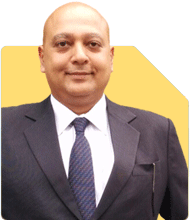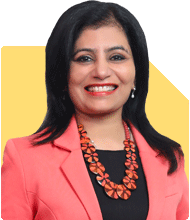52 Lakh Mutual Fund Portfolio Owner with 20 Lakh NSC Maturity: Invest in Land or Expand Portfolio?
Ramalingam Kalirajan |9757 Answers |Ask -Follow
Mutual Funds, Financial Planning Expert - Answered on Dec 02, 2024
He has an MBA in finance from the University of Madras and is a certified financial planner.
He is the director and chief financial planner at Holistic Investment, a Chennai-based firm that offers financial planning and wealth management advice.... more

Hi Sir Am holding 52L portfolio of mutual fund,with the investment of 40L with SIP of 50000. Am living in own house. Health insurance coverage upto 15L ULIP insurance upto 20 L Currently I have an NSC matured amount of 20L which will come in Jan 2025. Suggest me for better returns shall I invest in land,or plot Or Shall I distribute in my mutual fund portfoli? Am confused sir Your suggestions help me a lot sir
Living in your own house ensures reduced living costs, while a Rs. 15L health insurance cover provides excellent security against medical emergencies. However, ULIP investments worth Rs. 20L need reassessment for efficiency and returns.
The Rs. 20L from NSC maturing in January 2025 offers a golden opportunity to expand your wealth.
Why Real Estate May Not Be Ideal
1. High Initial Investment and Low Liquidity
Real estate investments demand significant funds upfront.
Selling plots or land can take time, reducing liquidity.
2. Maintenance and Legal Risks
Plots or land require maintenance and incur additional costs.
Legal disputes or encumbrances may cause complications.
3. Unpredictable Returns
Real estate returns are region-specific and may not outpace mutual fund returns.
Long holding periods may dilute the real returns due to inflation.
Why Enhance Your Mutual Fund Portfolio
1. Diversification Opportunities
Mutual funds offer sectoral and geographic diversification.
Broadening your portfolio helps reduce risk and boost returns.
2. Liquidity and Transparency
Mutual funds provide easy entry and exit options.
Regular updates and professional management ensure transparency.
3. Potential for Higher Returns
Actively managed equity funds can offer higher returns than fixed assets.
Regular portfolio rebalancing can optimise gains.
4. Flexibility
Systematic Transfer Plans (STPs) help stagger investments to reduce timing risks.
Investments align better with market conditions.
Reassessing ULIP Investments
1. Evaluate the Returns
ULIPs mix insurance and investment but may offer moderate returns.
Compare ULIP returns with mutual fund growth over similar periods.
2. Consider Surrendering
If ULIPs underperform, you can consider surrendering after the lock-in period.
Reallocate proceeds to mutual funds for better returns.
Suggested Strategy for Rs. 20L NSC Proceeds
1. Staggered Investment in Mutual Funds
Use an STP to invest the Rs. 20L gradually in equity mutual funds.
This reduces market risk and maximises returns.
2. Focus on Balanced Asset Allocation
Allocate funds to equity, hybrid, and debt mutual funds.
This ensures both growth and stability.
3. Explore Thematic or International Funds
Add funds focusing on specific sectors or global markets.
Diversify beyond traditional equity funds for higher growth potential.
Tax Implications of Mutual Fund Investments
1. Equity Mutual Funds
LTCG above Rs. 1.25 lakh is taxed at 12.5%.
STCG is taxed at 20%.
2. Debt Mutual Funds
Both LTCG and STCG are taxed as per your income tax slab.
Plan your holding period to optimise tax efficiency.
Finally
Investing in land or plots may not align with your financial goals due to lower liquidity and unpredictable returns. Distributing the Rs. 20L NSC maturity amount into diversified mutual funds will maximise growth and ensure financial flexibility.
Review your ULIP policies and consider shifting funds to mutual funds for better returns. Regularly consult a Certified Financial Planner to optimise your investments.
Best Regards,
K. Ramalingam, MBA, CFP,
Chief Financial Planner,
www.holisticinvestment.in
https://www.youtube.com/@HolisticInvestment
Steps to Secure Financial Independence
Retirement Corpus Calculation
Estimate your family’s annual expenses, including inflation. Multiply it by 25–30 to derive the retirement corpus needed.
Optimise Your Investments
Focus on equity mutual funds for growth and hybrid funds for stability. Allocate more to high-growth funds now, and gradually shift to conservative funds nearing 46.
Create Passive Income Sources
Use your current portfolio to generate regular income. Balanced advantage funds or SWPs in mutual funds provide steady cash flow.
Emergency and Health Funds
Increase your health insurance coverage to Rs. 25L. Ensure a contingency fund of 1–2 years’ expenses.
Transition to Lecturing
Skill Development
Start preparing by acquiring certifications or gaining expertise in your desired field.
Test the Waters
Take part-time opportunities to gain experience in lecturing before full-time transition.
Family Security
Kid’s Education Corpus
Use the Rs. 8L in SSY and additional investments to secure your child’s education.
Final Insight
Your disciplined savings and diversified portfolio make this goal achievable. A Certified Financial Planner can fine-tune your roadmap.
Best Regards,
K. Ramalingam, MBA, CFP,
Chief Financial Planner,
www.holisticinvestment.in
https://www.youtube.com/@HolisticInvestment
You may like to see similar questions and answers below
Ramalingam Kalirajan |9757 Answers |Ask -Follow
Mutual Funds, Financial Planning Expert - Answered on May 06, 2024
Ramalingam Kalirajan |9757 Answers |Ask -Follow
Mutual Funds, Financial Planning Expert - Answered on Oct 28, 2024
Ramalingam Kalirajan |9757 Answers |Ask -Follow
Mutual Funds, Financial Planning Expert - Answered on Oct 28, 2024
Ramalingam Kalirajan |9757 Answers |Ask -Follow
Mutual Funds, Financial Planning Expert - Answered on May 15, 2025
Sushil Sukhwani |614 Answers |Ask -Follow
Study Abroad Expert - Answered on Jul 16, 2025
Archana Deshpande |116 Answers |Ask -Follow
Image Coach, Soft Skills Trainer - Answered on Jul 16, 2025
Nayagam P P |8910 Answers |Ask -Follow
Career Counsellor - Answered on Jul 16, 2025
Nayagam P P |8910 Answers |Ask -Follow
Career Counsellor - Answered on Jul 16, 2025
Archana Deshpande |116 Answers |Ask -Follow
Image Coach, Soft Skills Trainer - Answered on Jul 16, 2025
Nayagam P P |8910 Answers |Ask -Follow
Career Counsellor - Answered on Jul 16, 2025
Dr Nagarajan J S K |1810 Answers |Ask -Follow
NEET, Medical, Pharmacy Careers - Answered on Jul 16, 2025
Dr Nagarajan J S K |1810 Answers |Ask -Follow
NEET, Medical, Pharmacy Careers - Answered on Jul 16, 2025
Dr Nagarajan J S K |1810 Answers |Ask -Follow
NEET, Medical, Pharmacy Careers - Answered on Jul 16, 2025
Nayagam P P |8910 Answers |Ask -Follow
Career Counsellor - Answered on Jul 16, 2025

























